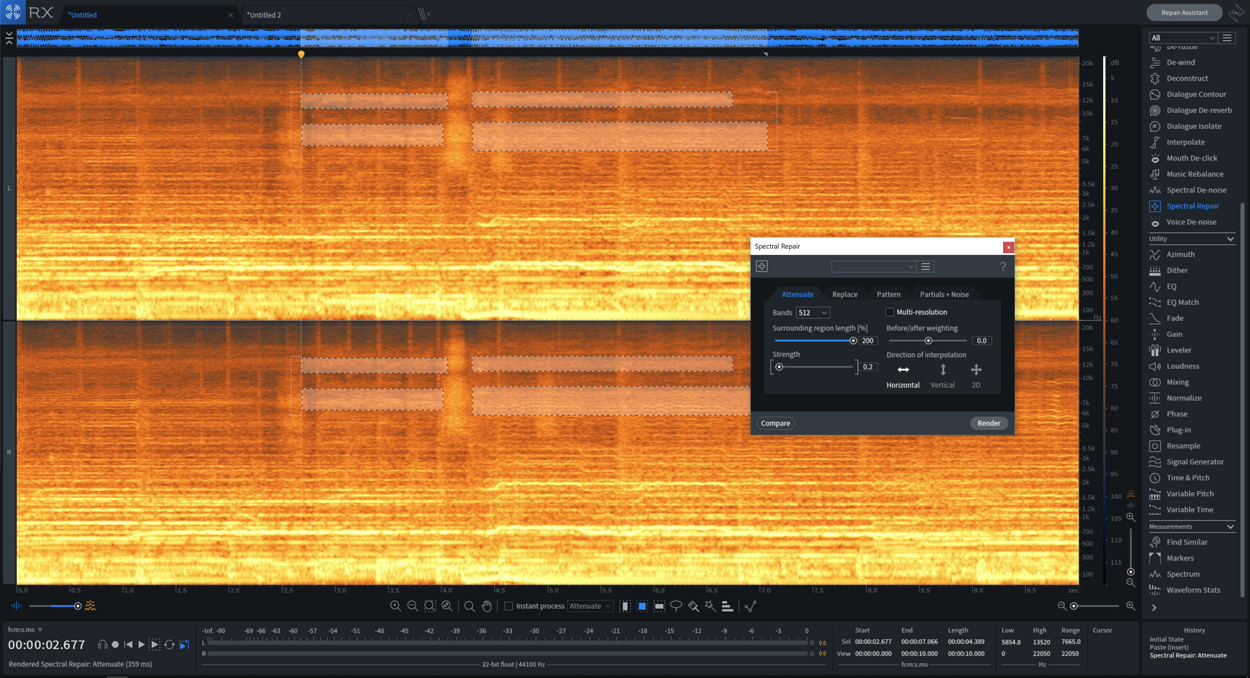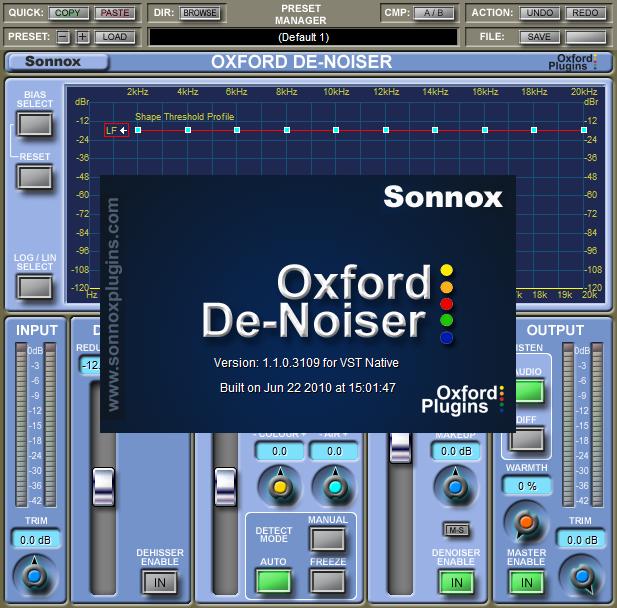Izotope Hum Removal
IZotope RX 2 is the most complete audio repair toolkit on the market, enabling you to remove noise, hiss, buzz and hum, eliminate clicks and crackle, restore clipped audio, visually select and suppress unwanted sounds, resynthesize missing audio and much more. Use RX in a variety of practical recording applications.

| Module & Plug-in |
|---|
Izotope Hum Removal Video
Overview
De-hum is designed to remove persistent tonal noise, like the AC hum that can be caused by poor electrical grounding. De-hum includes a series of notch filters that can be set to remove both the base frequency of the hum, usually 50 Hz (Europe) or 60 Hz (USA) as well as any harmonics. The De-hum module is effective for removing hum that has up to seven harmonics above its primary frequency.
Controls
- BASE FREQUENCY: Sets the fundamental frequency of the hum to be removed. The Free option unlocks the Notch Frequency control and allows you to manually identify the fundamental. With Preview engaged, adjust the slider until you find the point where the hum is appropriately reduced.
Tip
You can also use the Spectrum Analyzer to help identify the base frequency of the hum.
- SUGGEST: De-hum can intelligently identify the noise profile of the hum in your audio. Make a selection containing the hum in isolation, and click the Suggest button. This will automatically set the Base Frequency based on the learned profile. If you cannot find a selection of hum in isolation, RX can analyze any audio with prominent hum, but the results may not be as useful.
- ADAPTIVE MODE: Allows De-hum to adjust the notch filters based on changes in the audio over time. In this mode, RX will analyze incoming audio to determine what is hum and what is desired audio material. Adaptive mode will work better with hum that changes in pitch throughout the file.
- FILTER Q: Controls the bandwidth of the notch filters for the base frequency and all of the harmonics.
LINEAR-PHASE FILTERS: Linear-phase enables FIR (Finite Impulse Response) filters with a high FFT size. These filters provide very accurate frequency response with no change in phase at the expense of latency and filter pre-ringing.
Disabling Linear Phase (FIR) filters
- When Linear Phase is disabled, De-hum will use minimum-phase IIR filters. These are also very accurate, and are only susceptible to post-ringing, which is usually less noticeable than the pre-ringing introduced by FIR filters.
- Latency Consideration: Disabling Linear Phase Filters will reduce the latency used by De-hum when it is being used as a real-time plug-in.
- When Linear Phase is disabled, De-hum will use minimum-phase IIR filters. These are also very accurate, and are only susceptible to post-ringing, which is usually less noticeable than the pre-ringing introduced by FIR filters.
HIGH/LOW-PASS FILTERS: These traditional filters come ahead of the De-hum notch filters, and allow for frequencies to pass above or below a certain cutoff point. These can be useful for tackling extreme hum or buzz.
- FREQUENCY [Hz]: sets the cutoff frequency for the filter
- Q: Sets the bandwidth of the filter (or dB/octave cut). In the default IIR filter mode with a high Q setting, you may notice a resonance at the cutoff frequency characteristic of traditional analog filters. That resonance can be mitigated by engaging the Linear-phase filters.
- FREQUENCY [Hz]: sets the cutoff frequency for the filter
NUMBER OF HARMONICS: Because harmonics often accompany the fundamental frequency of a hum, De-hum can also attenuate these overtones with notch filters. Using the Number of Harmonics control, you can select up to 7 harmonics above the fundamental. The spectrogram display can make it easy to identify the harmonics. After selecting the number of harmonics, use the Slope control to set how aggressively the higher harmonics are attenuated.
LINK HARMONICS: Connects the gain controls of the notch filters.
- ALL: presents a single node on the display for controlling the gain of all the notch filters. This is the default setting.
- ODD/EVEN: presents two nodes on the display, one for controlling the gain of the fundamental frequency and even harmonics, and another for controlling the 1st harmonic and any following odd harmonics.
- NONE: presents individual gain nodes for the fundamental and each harmonic.
- ALL: presents a single node on the display for controlling the gain of all the notch filters. This is the default setting.
SLOPE: When harmonics are linked, this controls the harmonic slope of the gain nodes for each overtone. As the harmonic order increases, the gain level resolves closer to 0 dB. When the Link Harmonics control is set to Odd/Even, a separate control appears that affords independent control over the slope for both odd and even harmonics.
HARMONIC GAINS [dB]: This section provides a numerical readout of the notch filter gain settings in decibels. You can also manually enter gain settings for the fundamental, or any of the harmonics if Link Harmonics is set to None.
FILTER DC OFFSET: This checkbox will engage a filter to remove any DC (direct current) offset that sometimes occurs in A/D converters or analog circuits used in the recording process.
OUTPUT HUM ONLY: Selecting this check box will isolate the hum that is being removed. This is useful for fine-tuning your settings. Identify a section of your file where the hum is mixed with other material, select this mode, and click Preview. Now adjust parameters like Filter Q and Slope control to maximize hum removal, thus minimizing the effect on the program material.
It’s easy easy to modify the settings as well as add additional third effect packs. The simple keyboard commands are also straight-forward and helpful.With this application users can make as many live audio or instrument tracks you want including digital and MIDI tracks. It is a great way to record music, use MIDI instruments, and experiment with loops. The simplicity of the program compared to other music recording or editing software interfaces, it is easy to click, drag and drop also. Users have been easily able to produce your own music without having to pay for expensive and overly professional software that you will never know how to use.GarageBand excels in its simplicity and ease of access. Garageband for windows 10 free download.

Izotope Hum Removal Reviews
Isolate mix elements from a single track with the new source separation module in RX 7, Music Rebalance. Easily reduce vocals in background music for clearer dialogue, learn how to remove vocals from a song, or separate vocal stems from a track for easy remixing. May 20, 2018 Standalone Workflow Open the audio file in the RX Audio Editor or send it via RX Connect. Open the Corrective EQ module Option+Shift+7. Engage a high-pass filter to remove the most apparent rumble and to make any other static filtering gestures before applying the De-noiser. Sep 19, 2018 Izotope RX 7 - Easy Noise Reduction 'Fixing a Speech' 50% of RX 7 Right now - Find out more RX has been on the forefront of innovation.
More Information
Alternative Modules to use for Complex Hum Issues
- Izotope are the latest developers to release a suite of tools for tackling problem audio. As well as the usual noise–reduction algorithms, RX also includes clip.
- May 20, 2018 Standalone Workflow Open the audio file in the RX Audio Editor or send it via RX Connect. Open the Corrective EQ module Option+Shift+7. Engage a high-pass filter to remove the most apparent rumble and to make any other static filtering gestures before applying the De-noiser.
- Up to eight harmonics can be notched out using the hum filter in RX Hum Removal. This module also follows the format that's familiar from other hum–removal plug–ins. As well as the fundamental frequency of the hum, it can tackle up to eight harmonics.
- Spectral De-noise For hum that has many harmonics that extend into higher frequencies (often described as “buzz”), try using Spectral De-noise. Spectral De-noise features tonal noise reduction controls that can make short work of harmonic hum and buzz across the entire spectrum.
- De-click Some very high frequency buzz can also be removed with the De-click module.
Izotope Hum Removal Kit
Visual Example
Izotope Hum Removal Tool
This image shows the spectrogram of a file with 3 harmonics of a 60 Hz Hum:
Mix and scratch digital music on your computer with Serato Control Vinyl or Control CDs. Serato DJ Pro Download Serato DJ Lite Download Expansion Packs. Support for all current Rane Scratch Live hardware (SL 1, SL 2, SL 3, SL 4. Serato is pleased to announce the release of Serato Scratch Live 2.4.3, the latest free update for Serato Scratch Live DJs. This release adds support for the Serato Video 1.1 update but also has some very handy new features and improvements. Free Music & Video Downloader 2.33. Download some of the best music currently available using this free and easy software program. Splashtop Streamer 2.1.5.2. Allows access to your computer from your phone. Serato Scratch Live 2.4.3 free download. Serato scratch live 2.5. Scratch Live 2.3.3 includes a large rewrite of all MPEG-4 file reading and writing of meta data (tagging data). This includes.mp4,.m4a,.aac and many.mov files. One of these changes involves writing Serato meta data to files in a different way than previous versions of Scratch Live. Rane TTM 57SL users: Before updating to Scratch Live versions 2.4.0 and newer, make sure your Rane TTM 57SL mixer has the latest firmware version installed. Video-SL users: Video-SL is no longer supported in Scratch Live 2.4 and above. Video-SL has been replaced by Serato Video, which is a free upgrade for all existing Video-SL customers. Download Serato Video 1.0.